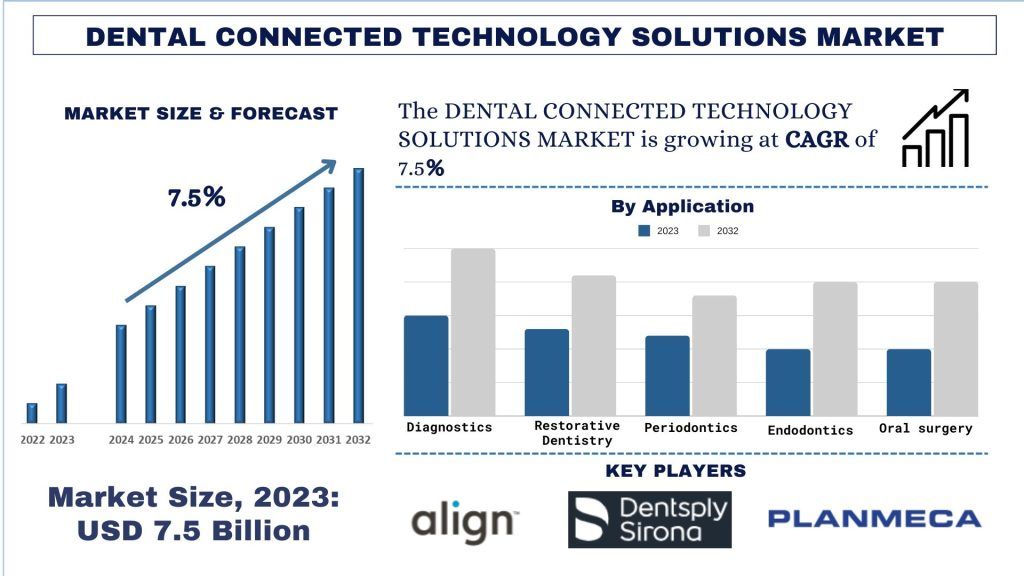- Startseite
- Über uns
- Industrie
- Dienstleistungen
- Lesen
- Kontaktieren Sie uns
Markt für vernetzte dentale Technologielösungen: Aktuelle Analyse und Prognose (2024-2032)
Schwerpunkt auf Typ (Dentalbildgebungssysteme, Praxisverwaltungssoftware, Dentale CAD/CAM-Systeme, Dentale Laser, Dentale Sensoren und Sonstige); Anwendung (Diagnostik, Restaurative Zahnheilkunde, Parodontologie, Endodontie und Oralchirurgie), Endverbraucher (Zahnkliniken & -praxen, Dentallabore und Sonstige); und Region/Land
Marktgröße und Prognose für Dental Connected Technology Solutions
Der Markt für Dental Connected Technology Solutions wurde im Jahr 2023 auf etwa 7,5 Milliarden USD geschätzt und wird voraussichtlich im Prognosezeitraum (2024-2032) mit einer starken CAGR von rund 7,5 % wachsen, was auf den steigenden Trend in der Zahnmedizin zurückzuführen ist.
Marktanalyse für Dental Connected Technology Solutions
Dental Connected Technology Solutions sind eine Sammlung elektronischer Instrumente und Systeme, die in Zahnarztpraxen eingesetzt werden, um modernste Technologien zu integrieren und klinische Ergebnisse, betriebliche Effektivität und Patientenversorgung zu verbessern. Digitale Bildgebungssysteme, elektronische Patientenakten (EHRs), Intraoralscanner, Telezahnmedizin-Plattformen und intelligente zahnmedizinische Geräte sind einige dieser Lösungen. Der zunehmende Einsatz digitaler Zahnmedizin, der Anstieg der Nachfrage nach Telezahnmedizin und die Betonung der patientenzentrierten Behandlung sind wichtige Faktoren, die diese Branche vorantreiben.
Zum Beispiel besuchten in den Vereinigten Staaten im Jahr 2019 etwa 64,9 % der Erwachsenen im vergangenen Jahr einen Zahnarzt, so die Centers for Disease Control and Prevention (CDC).
Zum Beispiel stellte die American Association of Orthodontists (AAO) fest, dass sich im Jahr 2020 in den Vereinigten Staaten etwa 4 Millionen Menschen in kieferorthopädischer Behandlung befinden.
Zum Beispiel schätzte die American Association of Endodontists (AAE), dass im Jahr 2019 in den Vereinigten Staaten jährlich mehr als 15 Millionen Wurzelkanalbehandlungen durchgeführt werden.
Markttrends für Dental Connected Technology Solutions
In diesem Abschnitt werden die wichtigsten Markttrends erörtert, die die verschiedenen Segmente des Marktes für Dental Connected Technology Solutions beeinflussen, wie sie von unserem Team von Forschungsexperten identifiziert wurden.
Steigende Nachfrage nach minimalinvasiven Eingriffen
Die Dentalindustrie erlebt eine bedeutende Verlagerung hin zu minimalinvasiven Eingriffen, die durch die Präferenz der Patienten für weniger schmerzhafte, effizientere und schnellere Erholungsbehandlungen angetrieben wird. Dieser Trend treibt die Akzeptanz von Dental Connected Technology Solutions voran, die fortschrittliche Diagnose-, Planungs- und Behandlungsmöglichkeiten bieten, die für die minimalinvasive Zahnmedizin unerlässlich sind. Zum Beispiel bevorzugen laut der American Academy of Cosmetic Dentistry (AACD, 2020) 74 % der Patienten Zahnarztpraxen, die fortschrittliche Technologie und minimalinvasive Optionen anbieten.
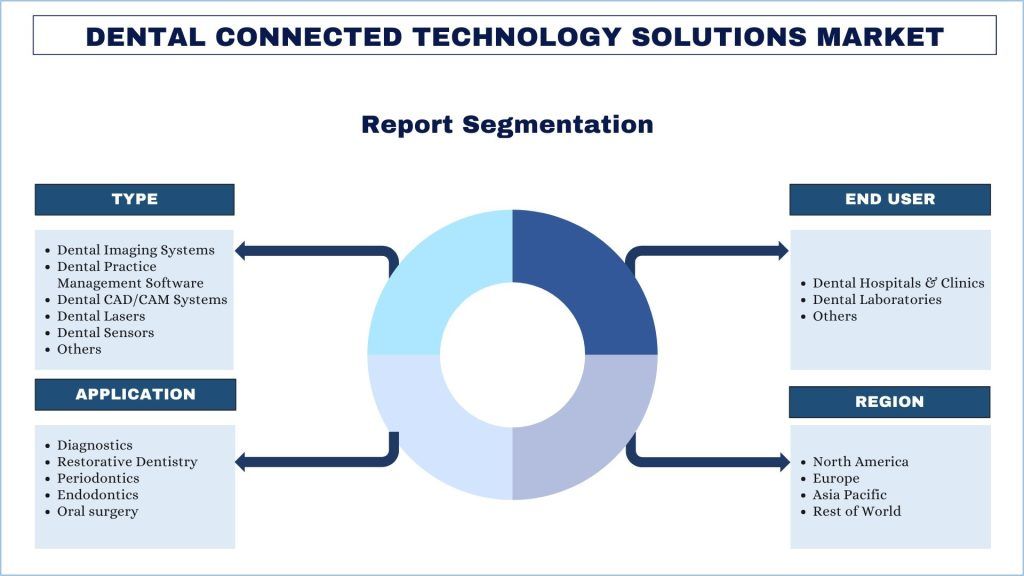
Nordamerika wird voraussichtlich im Prognosezeitraum mit einer signifikanten CAGR wachsen
Der Markt für Dental Connected Technology Solutions in Nordamerika hat in den letzten Jahren ein signifikantes Wachstum erfahren, das durch verschiedene Faktoren angetrieben wird. Nordamerika, insbesondere die USA, ist einer der größten Märkte für Dental Connected Technology Solutions weltweit. Einer der Haupttreiber des Marktes für Dental Connected Technology Solutions in Nordamerika ist die hohe Nachfrage nach fortschrittlicher Zahnpflege und digitalen Lösungen. Zum Beispiel hatten laut der American Dental Association (ADA) im Jahr 2021 über 70 % der Zahnarztpraxen in den USA digitale Radiographie eingeführt, was den Wandel hin zu digitalen Werkzeugen widerspiegelt. Darüber hinaus verfügt Nordamerika über einen gut etablierten Regulierungsrahmen, der die Sicherheit und Wirksamkeit von Dentaltechnologien gewährleistet.
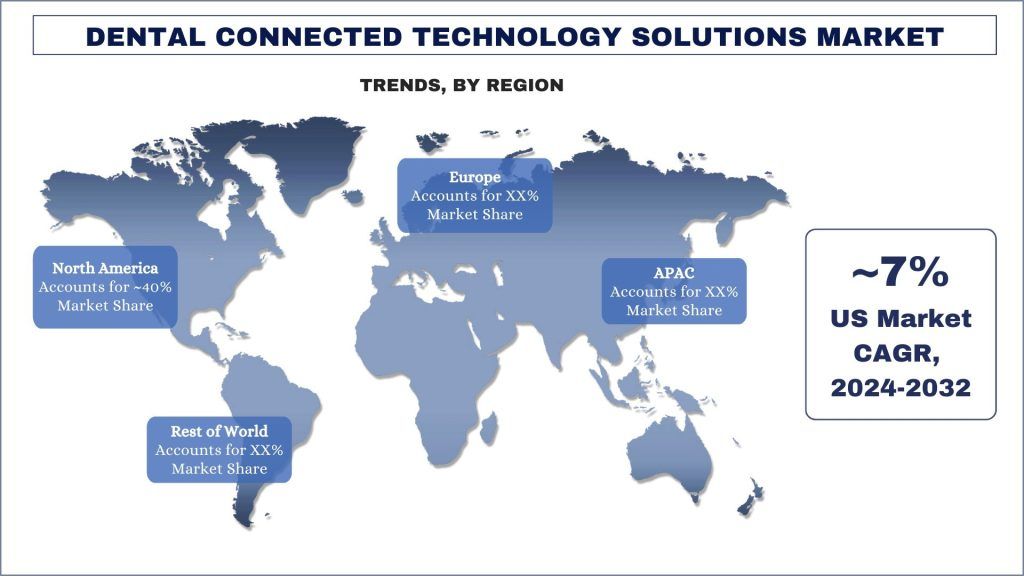
Branchenüberblick über Dental Connected Technology Solutions
Der Markt für Dental Connected Technology Solutions ist wettbewerbsintensiv und es gibt mehrere globale und internationale Marktteilnehmer. Die wichtigsten Akteure verfolgen unterschiedliche Wachstumsstrategien, um ihre Marktpräsenz zu verbessern, wie z. B. Partnerschaften, Vereinbarungen, Kooperationen, Produkteinführungen, geografische Expansionen sowie Fusionen und Übernahmen. Einige der wichtigsten Akteure auf dem Markt sind Align Technology, Dentsply Sirona, Planmeca Oy, Carestream Dental. 3M, Ivoclar Vivadent, Henry Schein, Open Dental, Eaglesoft und Koninklijke Philips N.V.
Berichtsabdeckung für den Markt für Dental Connected Technology Solutions
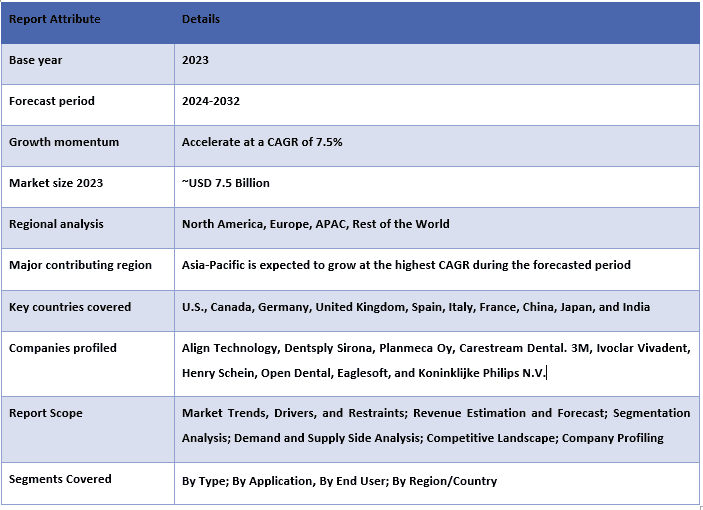
Gründe für den Kauf dieses Berichts:
- Die Studie umfasst eine Marktdimensionierungs- und Prognoseanalyse, die von authentifizierten wichtigen Branchenexperten validiert wurde.
- Der Bericht bietet einen schnellen Überblick über die Gesamtleistung der Branche auf einen Blick.
- Der Bericht enthält eine eingehende Analyse der wichtigsten Branchenkollegen mit einem primären Fokus auf wichtige Finanzkennzahlen, Produktportfolios, Expansionsstrategien und aktuelle Entwicklungen.
- Detaillierte Untersuchung der Treiber, Beschränkungen, wichtigsten Trends und Chancen, die in der Branche vorherrschen.
- Die Studie deckt den Markt umfassend über verschiedene Segmente hinweg ab.
- Tiefgreifende regionale Analyse der Branche.
Anpassungsoptionen:
Der globale Markt für Dental Connected Technology Solutions kann gemäß den Anforderungen oder einem anderen Marktsegment weiter angepasst werden. Darüber hinaus versteht UMI, dass Sie möglicherweise Ihre eigenen geschäftlichen Anforderungen haben. Zögern Sie daher nicht, sich mit uns in Verbindung zu setzen, um einen Bericht zu erhalten, der Ihren Anforderungen vollständig entspricht.
Inhaltsverzeichnis
Forschungsmethodik für die Marktanalyse von Dental Connected Technology Solutions (2024-2032)
Die Analyse des historischen Marktes, die Schätzung des aktuellen Marktes und die Prognose des zukünftigen Marktes des globalen Marktes für Dental Connected Technology Solutions waren die drei wichtigsten Schritte zur Erstellung und Analyse der Akzeptanz von Dental Connected Technology Solutions in wichtigen Regionen weltweit. Umfassende Sekundärforschung wurde durchgeführt, um die historischen Marktzahlen zu erfassen und die aktuelle Marktgröße zu schätzen. Zweitens wurden zahlreiche Erkenntnisse und Annahmen berücksichtigt, um diese Erkenntnisse zu validieren. Darüber hinaus wurden ausführliche Primärinterviews mit Branchenexperten entlang der Wertschöpfungskette des globalen Marktes für Dental Connected Technology Solutions geführt. Nach der Annahme und Validierung der Marktzahlen durch Primärinterviews wendeten wir einen Top-Down/Bottom-Up-Ansatz an, um die vollständige Marktgröße zu prognostizieren. Danach wurden Methoden zur Marktaufteilung und Datentriangulation angewendet, um die Marktgröße von Segmenten und Subsegmenten der Branche zu schätzen und zu analysieren. Die detaillierte Methodik wird im Folgenden erläutert:
Analyse der historischen Marktgröße
Schritt 1: Eingehende Studie von Sekundärquellen:
Eine detaillierte Sekundärstudie wurde durchgeführt, um die historische Marktgröße des Marktes für Dental Connected Technology Solutions durch unternehmensinterne Quellen wie Geschäftsberichte und Finanzberichte, Performance-Präsentationen, Pressemitteilungen usw. und externe Quellen wie Fachzeitschriften, Nachrichten und Artikel, Regierungsveröffentlichungen, Wettbewerberveröffentlichungen, Sektorberichte, Datenbanken von Drittanbietern und andere glaubwürdige Veröffentlichungen zu erhalten.
Schritt 2: Marktsegmentierung:
Nachdem wir die historische Marktgröße des Marktes für Dental Connected Technology Solutions erhalten hatten, führten wir eine detaillierte Sekundäranalyse durch, um historische Markteinblicke und Anteile für verschiedene Segmente und Subsegmente für wichtige Regionen zu sammeln. Wichtige Segmente sind im Bericht als Typ, Anwendung, Endverbraucher und Regionen enthalten. Darüber hinaus wurden Länderanalysen durchgeführt, um die allgemeine Akzeptanz von Testmodellen in dieser Region zu bewerten.
Schritt 3: Faktorenanalyse:
Nachdem wir die historische Marktgröße verschiedener Segmente und Subsegmente erfasst hatten, führten wir eine detaillierte Faktorenanalyse durch, um die aktuelle Marktgröße des Marktes für Dental Connected Technology Solutions zu schätzen. Darüber hinaus führten wir eine Faktorenanalyse unter Verwendung abhängiger und unabhängiger Variablen wie Typ, Anwendung, Endverbraucher und Regionen des Marktes für Dental Connected Technology Solutions durch. Eine gründliche Analyse wurde für Nachfrage- und Angebotsseitenszenarien unter Berücksichtigung von Top-Partnerschaften, Fusionen und Übernahmen, Geschäftsausweitungen und Produkteinführungen im Bereich Dental Connected Technology Solutions weltweit durchgeführt.
Aktuelle Markgrößenschätzung und -prognose
Aktuelle Marktgröße: Basierend auf den umsetzbaren Erkenntnissen aus den oben genannten 3 Schritten haben wir die aktuelle Marktgröße, die wichtigsten Akteure auf dem globalen Markt für Dental Connected Technology Solutions und die Marktanteile der Segmente ermittelt. Alle erforderlichen prozentualen Anteile und Marktaufschlüsselungen wurden anhand des oben genannten sekundären Ansatzes ermittelt und durch Primärinterviews verifiziert.
Schätzung & Prognose: Für die Marktschätzung und -prognose wurden verschiedene Faktoren gewichtet, darunter Treiber & Trends, Beschränkungen und Chancen, die den Stakeholdern zur Verfügung stehen. Nach der Analyse dieser Faktoren wurden relevante Prognosetechniken, d. h. der Top-Down/Bottom-Up-Ansatz, angewendet, um die Marktprognose für 2032 für verschiedene Segmente und Subsegmente in den wichtigsten Märkten weltweit zu erstellen. Die Forschungsmethodik zur Schätzung der Marktgröße umfasst:
- Die Marktgröße der Branche in Bezug auf den Umsatz (USD) und die Akzeptanzrate des Marktes für Dental Connected Technology Solutions in den wichtigsten Märkten im Inland
- Alle prozentualen Anteile, Aufteilungen und Aufschlüsselungen von Marktsegmenten und Subsegmenten
- Wichtige Akteure auf dem globalen Markt für Dental Connected Technology Solutions in Bezug auf die angebotenen Produkte. Außerdem die Wachstumsstrategien, die diese Akteure anwenden, um in dem schnell wachsenden Markt zu konkurrieren.
Validierung der Marktgröße und des Marktanteils
Primärforschung: Es wurden ausführliche Interviews mit den wichtigsten Meinungsbildnern (Key Opinion Leaders, KOLs) geführt, darunter Führungskräfte der obersten Ebene (CXO/VPs, Vertriebsleiter, Marketingleiter, Betriebsleiter, Regionalleiter, Landesleiter usw.) in wichtigen Regionen. Die Ergebnisse der Primärforschung wurden dann zusammengefasst und eine statistische Analyse durchgeführt, um die aufgestellte Hypothese zu beweisen. Die Erkenntnisse aus der Primärforschung wurden mit den Ergebnissen der Sekundärforschung zusammengeführt, wodurch Informationen in umsetzbare Erkenntnisse umgewandelt wurden.
Aufteilung der primären Teilnehmer in verschiedene Regionen
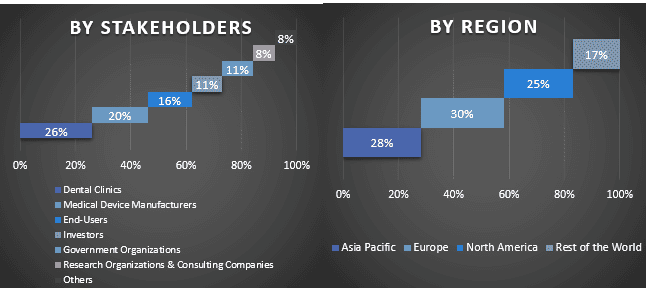
Markt Engineering
Die Datentriangulationstechnik wurde angewendet, um die Gesamtmarktschätzung abzuschließen und präzise statistische Zahlen für jedes Segment und Subsegment des globalen Marktes für Dental Connected Technology Solutions zu erhalten. Die Daten wurden in mehrere Segmente und Subsegmente aufgeteilt, nachdem verschiedene Parameter und Trends in den Bereichen Typ, Anwendung, Endverbraucher und Regionen auf dem globalen Markt für Dental Connected Technology Solutions untersucht wurden.
Das Hauptziel der globalen Marktstudie für Dental Connected Technology Solutions
Die aktuellen und zukünftigen Markttrends des globalen Marktes für Dental Connected Technology Solutions wurden in der Studie genau bestimmt. Investoren können strategische Erkenntnisse gewinnen, um ihre Diskretion für Investitionen auf die in der Studie durchgeführte qualitative und quantitative Analyse zu stützen. Aktuelle und zukünftige Markttrends bestimmten die Gesamtattraktivität des Marktes auf regionaler Ebene und boten dem industriellen Teilnehmer eine Plattform, um den unerschlossenen Markt auszuschöpfen, um von einem First-Mover-Vorteil zu profitieren. Weitere quantitative Ziele der Studien sind:
- Analyse der aktuellen und prognostizierten Marktgröße des Marktes für Dental Connected Technology Solutions in Bezug auf den Wert (USD). Analysieren Sie auch die aktuelle und prognostizierte Marktgröße verschiedener Segmente und Subsegmente.
- Zu den Segmenten in der Studie gehören die Bereiche Typ, Anwendung, Endverbraucher und Regionen.
- Definition und Analyse des regulatorischen Rahmens für Dental Connected Technology Solutions
- Analyse der Wertschöpfungskette unter Beteiligung verschiedener Intermediäre sowie Analyse des Kunden- und Wettbewerberverhaltens der Branche.
- Analyse der aktuellen und prognostizierten Marktgröße des Marktes für Dental Connected Technology Solutions für die Hauptregion.
- Zu den wichtigsten Ländern der in dem Bericht untersuchten Regionen gehören Asien-Pazifik, Europa, Nordamerika und der Rest der Welt.
- Unternehmensprofile des Marktes für Dental Connected Technology Solutions und die Wachstumsstrategien, die von den Marktteilnehmern angewendet werden, um in dem schnell wachsenden Markt zu bestehen.
- Tiefgreifende regionale Analyse der Branche
Häufig gestellte Fragen FAQs
F1: Wie groß ist der aktuelle Markt für Dental Connected Technology Solutions und welches Wachstumspotenzial hat er?
F2: Was sind die treibenden Faktoren für das Wachstum des Marktes für Dental Connected Technology Solutions?
F3: Welches Segment hat den größten Anteil am Markt für Dental Connected Technology Solutions nach Typ?
F4: Welche aufkommenden Technologien und Trends gibt es auf dem Markt für Dental Connected Technology Solutions?
F5: Welche Region wird den Markt für vernetzte Dentaltechnologielösungen dominieren?
Verwandt Berichte
Kunden, die diesen Artikel gekauft haben, kauften auch

